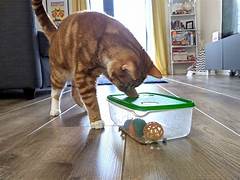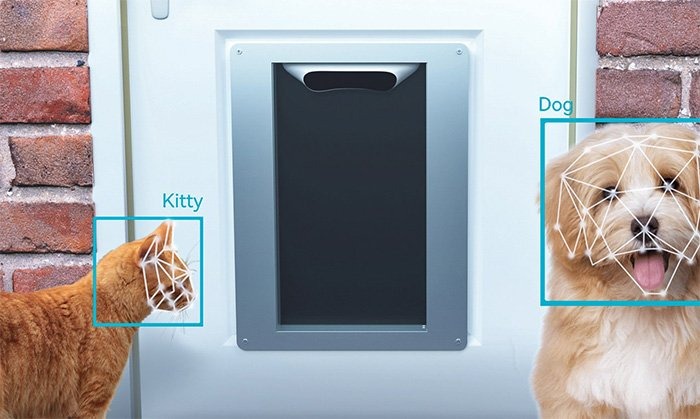
Fun DIY Toys for Cats Using Household Items.
Discover how to turn everyday household items into exciting, safe, and budget-friendly toys that will keep your cat mentally stimulated and physically active. From cardboard puzzles to feather wands, these DIY ideas are perfect for pet parents who want to bond with their feline friends while promoting healthy, playful behavior—all without spending a dime.
🐶 Pet Star
46 min read · 20, Jul 2025

Fun DIY Toys for Cats Using Household Items
Cats are curious, playful creatures who thrive on stimulation and engagement. While pet stores offer a wide variety of toys, many of them come with a price tag that isn’t always necessary. What if you could make entertaining, safe, and engaging toys for your feline friend using items you already have at home?
Creating DIY toys is not only cost-effective, but it also gives you the opportunity to personalize playtime for your cat. Whether your feline is a high-energy jumper, a stealthy stalker, or a gentle paw-swatting kitty, there’s a homemade toy to suit their style. In this article, we’ll explore creative, easy, and safe ways to make toys using common household materials—no special tools or expertise needed!
Why DIY Toys for Cats?
Before diving into the projects, it's worth understanding the benefits of DIY toys:
- Cost-Effective: No need to spend extra on commercial toys.
- Eco-Friendly: Reuse and recycle materials instead of throwing them away.
- Customizable: Tailor each toy to your cat’s play habits and preferences.
- Bonding Opportunity: Making toys can be a fun activity for the whole family, and watching your cat enjoy them is rewarding.
Safety First: Tips Before You Start
Before crafting DIY toys, keep these safety tips in mind:
- Avoid small parts that can be swallowed.
- Don’t use toxic materials, such as certain glues, paints, or plastics.
- Supervise your cat, especially when introducing a new toy.
- Check for wear and tear and replace homemade toys regularly.
DIY Toy Ideas Using Common Household Items
Let’s explore creative, fun, and feline-approved toy ideas using everyday household materials.
1. Toilet Paper Roll Treat Puzzle
Materials Needed:
- Empty toilet paper roll
- Cat treats
- Scissors
How to Make:
- Flatten the roll and cut small holes on all sides—just big enough for treats to fall out.
- Place some treats or kibble inside the roll.
- Pop the roll back into a cylindrical shape and give it to your cat.
Why It Works: This toy stimulates your cat’s foraging instinct, encouraging mental and physical activity.
2. Sock Catnip Kicker
Materials Needed:
- Old clean sock
- Dried catnip
- Cotton or shredded paper for stuffing
- Needle and thread (optional)
How to Make:
- Fill the sock with cotton or paper and a generous amount of catnip.
- Tie the end tightly or sew it shut.
- Toss it to your cat and watch them kick away!
Why It Works: Cats love kicking and bunny-kicking long soft objects, especially when catnip is involved.
3. Crinkle Ball from Candy Wrappers
Materials Needed:
- Clean candy wrappers or cellophane
- Aluminum foil (optional)
- String (optional)
How to Make:
- Crumple the candy wrapper into a tight ball.
- You can wrap it with a small piece of aluminum foil for added texture.
- Optional: tie it to a string and dangle it.
Why It Works: The sound and texture trigger curiosity and encourage batting and chasing.
4. DIY Feather Wand
Materials Needed:
- A stick (e.g., chopstick or pencil)
- String or yarn
- Feathers or ribbons
- Tape or glue
How to Make:
- Tie feathers or ribbons securely to the end of the string.
- Attach the other end of the string to the stick.
- Wave it around like a wand!
Why It Works: This toy replicates prey movement and is perfect for interactive play.
5. Cardboard Box Maze
Materials Needed:
- Multiple cardboard boxes
- Scissors or box cutter
- Tape
How to Make:
- Cut holes in the sides of each box.
- Tape boxes together to form a tunnel or maze.
- Place toys or treats inside.
Why It Works: Great for exploration, hiding, and ambush play.
6. Bottle Cap Chase
Materials Needed:
- Plastic bottle caps (clean and smooth-edged)
How to Use:
- Simply flick the cap across the floor and let your cat chase it.
- Add a few on the floor to make a mini obstacle game.
Why It Works: They slide fast on smooth floors, triggering a cat’s chase response.
7. Paper Bag Hideout
Materials Needed:
- Paper grocery bag (no handles)
How to Use:
- Open the bag and place it on the floor.
- You can add toys or treats inside.
Why It Works: Cats love the sound of crinkly paper and small hiding places.
8. Yarn Spider Toy
Materials Needed:
- Yarn or string
- Pom-pom or soft toy
- Scissors
How to Make:
- Cut yarn into equal lengths (6–8 inches).
- Tie them to the center around a small pom-pom to resemble legs.
- Drag or dangle it to mimic a crawling insect.
Why It Works: Stimulates hunting instincts and offers interactive fun.
9. Egg Carton Puzzle Feeder
Materials Needed:
- Empty egg carton (cardboard or plastic)
- Cat treats or kibble
How to Use:
- Place treats inside the egg cups.
- Your cat has to paw them out one by one.
Why It Works: Provides mental stimulation and slows down fast eaters.
10. T-Shirt Tent for Lounging
Materials Needed:
- Old T-shirt
- Wire hangers
- Cardboard base
- Tape
How to Make:
- Bend wire hangers into a dome shape and tape them securely to the cardboard.
- Stretch the T-shirt over the frame so the neck hole becomes the “door.”
- Tuck the sleeves and bottom under the base.
Why It Works: A cozy, hideaway spot for cats to nap after play.
Maintenance Tips for DIY Cat Toys
- Clean cloth-based toys regularly to avoid bacteria.
- Replace items that become frayed, torn, or chewed.
- Monitor usage to ensure toys remain safe and engaging.
Fun Add-Ons
- Add a dab of catnip spray for extra interest.
- Rotate toys weekly to keep playtime fresh.
- Add jingle bells securely inside soft toys for sound stimulation (supervised only).
Creating fun and engaging toys for your cat doesn’t require a trip to the pet store or a big budget—many of the most stimulating and enjoyable cat toys can be made using simple household items. DIY cat toys are not only cost-effective but also eco-friendly, allowing you to recycle materials like cardboard, socks, string, and paper into engaging tools that stimulate your cat’s natural instincts. Cats, whether kittens or adults, have an innate need for play, which mimics hunting behaviors such as stalking, chasing, pouncing, and capturing. Providing these outlets through toys is vital for their physical health and mental stimulation. One of the simplest and most effective DIY toys is the toilet paper roll treat puzzle—just take an empty roll, cut holes in it, place some treats or kibble inside, and watch as your cat bats it around to get the rewards. This is perfect for encouraging problem-solving and satisfying their foraging instincts. Old socks can also be repurposed into catnip kickers—by filling them with cotton or shredded paper and dried catnip, then tying or sewing the end shut, you give your cat a soft object to kick and wrestle with, perfect for high-energy play. Candy wrappers or crinkly paper can be turned into balls that offer auditory stimulation with every swat or chase. For more interactive play, a feather wand made from a stick, string, and some feathers or ribbon can mimic the fluttery motion of prey, making it ideal for bonding sessions and exercise. Cats are also known to love cardboard boxes, and by cutting entry and exit holes in multiple boxes and taping them together, you can create a tunnel maze that promotes exploration and hiding—important for cats who enjoy stalking or lounging in enclosed spaces. A simple bottle cap can become a fun sliding toy on smooth floors, especially if flicked across the room to trigger your cat’s chase instinct. Paper bags, particularly grocery bags with the handles removed for safety, can serve as crinkly hideouts or ambush zones that are particularly exciting to curious cats. Yarn or string can be used to create spider-like toys—just tie multiple strands around a pom-pom and drag it across the floor to mimic a bug, which many cats love to hunt. You can also repurpose an egg carton into a treat puzzle by placing food in each cup and letting your cat fish them out one by one, which helps slow down fast eaters and adds a layer of mental challenge. For comfort, an old T-shirt, wire hangers, and a piece of cardboard can be fashioned into a soft tent—bend the hangers into arches, tape them to the cardboard base, then stretch the shirt over the frame so that the neck becomes a doorway, giving your cat a cozy hideaway to rest in after play. To ensure safety, always avoid materials that are toxic, easily ingested, or contain small parts that could pose a choking hazard. Supervision is essential when introducing a new toy, especially ones involving string, wire, or components that can unravel. Rotate toys weekly to maintain novelty and prevent boredom—just like humans, cats can tire of repetitive entertainment. It’s also good to add sensory elements to toys, such as the sound of a bell, the feel of different textures, or the smell of catnip, which around 60–70% of cats find highly stimulating. Some cats may not react to catnip, but for those that do, including it in toys like sock kickers or sprayed on cardboard boxes can elevate their interest. For added excitement, tie toys to string and drag them or suspend them from door handles for solo play. Maintenance is also important—wash fabric-based toys regularly, dispose of damaged items, and avoid anything that frays into sharp strands, such as some types of string or plastic. DIY toys provide an excellent bonding experience between pet and owner, encourage natural behaviors, and help relieve boredom, especially for indoor cats who may lack environmental variety. In conclusion, making DIY toys for cats using household items is a rewarding, affordable, and creative way to improve your pet’s life. Whether it's through puzzle feeders, chasable toys, cozy hideaways, or interactive wands, you’re providing your feline friend with the stimulation they crave, keeping them active, happy, and mentally engaged. Always prioritize safety, observe how your cat interacts with each toy, and adjust your designs based on their preferences. With a bit of imagination and care, you can turn everyday items into a world of fun for your furry companion without spending a dime.
Cats are curious, intelligent, and naturally playful creatures, and providing them with stimulating toys is crucial for their physical health, mental engagement, and emotional well-being—but you don’t need to spend a fortune on store-bought toys to keep your feline friend entertained, because many of the best toys can be made using simple, everyday household items that you probably already have lying around. DIY toys are not only cost-effective but also environmentally friendly, as they allow you to repurpose and recycle items such as cardboard, fabric, string, paper, and plastic in creative and enriching ways that appeal to your cat’s instincts, particularly those related to hunting, stalking, and pouncing. One of the simplest and most entertaining DIY toys you can make is a toilet paper roll puzzle feeder: by flattening an empty roll, cutting a few small holes in it, filling it with dry treats or kibble, and then restoring it to its cylindrical shape, you give your cat a stimulating challenge that rewards effort with food, engaging both their mind and body. Similarly, an old sock can be turned into a catnip kicker toy by stuffing it with shredded paper, cotton, or fabric scraps, adding a generous amount of dried catnip (if your cat enjoys it), and securely tying or sewing the end closed—this makes a perfect toy for cats to grab, kick, and wrestle with, helping release pent-up energy. For auditory stimulation, candy wrappers, aluminum foil, or crinkly packaging can be crumpled into small balls that make exciting noises when swatted across the floor, encouraging chase and play behaviors; just be sure the materials are non-toxic and large enough not to be swallowed. An interactive feather wand can be made by attaching feathers, strings, or ribbons to a stick or wooden dowel using tape or glue, allowing you to mimic the erratic movements of a bird or insect and engage in energetic, bonding play sessions with your cat. For the DIY enthusiast with a few cardboard boxes on hand, you can build a customizable cat maze or tunnel system by cutting entry and exit holes into each box and taping them together—add small toys, balls, or treats inside for exploration and discovery, which cats particularly enjoy. Even something as simple as a clean, handle-less paper bag placed on the floor can become an irresistible hideout or ambush zone, thanks to the appealing sound and texture of crinkly paper. Another fast and fun option is to use plastic bottle caps, which slide easily across hard floors; flick one and your cat will likely dart after it, engaging their prey-chase instincts. If you have yarn or soft string, you can create a “yarn spider” by tying multiple short strands around a central pom-pom or cloth ball—drag this along the ground and it will look like a moving bug, which many cats find impossible to resist. Egg cartons also make great puzzle feeders: simply place a piece of dry food in each section and let your cat bat the pieces out, slowing down their eating and adding a layer of challenge. For a more relaxing or cozy DIY project, consider building a T-shirt tent by stretching an old shirt over a frame made from bent wire hangers and a sturdy cardboard base, with the shirt’s neck acting as the entrance—cats love having a soft, dark place to hide and nap after a vigorous play session. It’s important to remember that safety should always come first when creating or introducing new toys: avoid small detachable pieces that can be swallowed, stay away from toxic glues or paints, and always monitor your cat’s behavior, especially with string-based or crinkly toys that might present a choking hazard if torn apart. Supervision is especially necessary when testing a new toy, and damaged or worn items should be replaced immediately to avoid any risk of injury. To keep things fresh and exciting, rotate your cat’s toys every few days so they don’t get bored, and consider enhancing playtime with sensory triggers such as scent (catnip or silvervine), sound (bells or crinkly paper), and movement (wands or hanging toys). Some cats may not respond to catnip, but for those who do, it can significantly increase their interest in a toy—use it in moderation and observe your cat’s behavior to see what works best. The variety of toys you can make is nearly endless, and the best ones often mimic the sights, sounds, or behaviors of natural prey, offering both solo and interactive play opportunities that cater to different feline personalities. Whether your cat is high-energy and needs lots of stimulation or more reserved and prefers quiet pawing games, there’s a DIY toy to match. Ultimately, crafting toys at home gives you not just an affordable and practical way to enrich your cat’s daily life but also a chance to bond with your pet in a more meaningful way, as you observe what makes them happiest and create more of what they love. From puzzle feeders made of cardboard rolls and egg cartons, to tactile sock kickers and dancing feather wands, every toy you make is a way of showing care while keeping your cat physically active and mentally sharp. Cats thrive in enriched environments where they can express natural behaviors safely and frequently, and DIY toys are a simple but powerful way to provide that enrichment using minimal resources and maximum love.
Conclusion
Homemade toys are a fantastic way to keep your feline friend engaged while saving money and promoting sustainability. From crinkly balls to cardboard mazes and catnip kickers, the possibilities are as limitless as your imagination. Always keep safety in mind and take a few moments to supervise your cat with any new creation. Whether your goal is to enrich your cat’s environment, reduce boredom, or simply bond with your pet, DIY toys offer a rewarding solution.
Key Takeaways:
- Use safe, clean materials like cardboard, socks, or string.
- Always observe your cat while they play with a new toy.
- Simple designs often provide the most joy.
- Rotate toys for variety and to keep your cat curious.
Q&A Section
Q1:- What household items are safe for making cat toys?
Ans:- Items like cardboard, old socks, yarn, feathers, paper bags, and empty toilet paper rolls are generally safe, as long as they are clean and don’t have small parts that can be swallowed.
Q2:- Are DIY toys better than store-bought toys?
Ans:- DIY toys can be just as effective, if not more so, because they are customizable and made with love. They are cost-efficient and eco-friendly, too.
Q3:- How can I make toys more interesting for my cat?
Ans:- Incorporate sound (crinkly paper, bells), smell (catnip), or movement (dangling toys). Also, rotate toys weekly to avoid boredom.
Q4:- Can I leave my cat alone with homemade toys?
Ans:- Some toys, like cardboard boxes or paper balls, are safe unsupervised. However, toys with string, small parts, or sharp edges should be used only under supervision.
Q5:- How often should I replace homemade cat toys?
Ans:- Inspect toys weekly. Replace immediately if damaged or dirty to avoid any potential harm to your pet.
Similar Articles
Find more relatable content in similar Articles

How Climate Change Affects Wild and Domestic Animals...
Climate change is dramatically.. Read More

Sustainable Pet Products: What to Look for in 2025...
As sustainability becomes a ce.. Read More

Smart Homes for Pets: Automated Feeders, Doors, and Mo..
As smart home technology advan.. Read More

Senior Pet Adoption: Why Older Animals Make the Best C..
Adopting a senior pet is a pro.. Read More
Explore Other Categories
© 2024 Copyrights by rPets. All Rights Reserved.